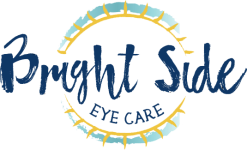There has long since been debunked the myth that those who have astigmatism cannot wear contact lenses. With our experience in custom contact lenses, we can assist people with astigmatism to see clearly without the need for glasses. Several of our patients had previously been told they couldn’t wear contact lenses due to the shape of their eyes. We were able to alter that viewpoint, though. That was untrue, though, and they could have obtained the proper fit with just the help of an experienced practitioner.
The ophthalmologists at Brightside can properly fit your eyes with the contact lenses that are best suited for them if you’re interested in switching from glasses to contact lenses. One of the most common types of contact lenses that astigmatists prefer to use in their eyes is toric lenses. Toric contact lenses are unique in the way that they were designed to help people with astigmatism see clearly at a range of distances.
Utilizing our vast knowledge and expertise in contact lens fitting, we at Brightside can assist our patients in finding a solution for visual clarity that does not include the use of glasses.
Contact Lenses for Astigmatizing Patients
It is believed that astigmatism stems from a cornea or lens with an abnormal curvature. Unlike a conventional cornea, which has a spherical form, an astigmatic cornea contains misplaced curves that produce distortion in vision at all distances. A lens with a different curve that produces the same effect can potentially cause visual issues.
Astigmatic patients had few options when it came to contact lenses in the past, and some were labeled as having “hard-to-fit” eyes. Nevertheless, this is no longer the case. Brightside’s eye care specialists can fit patients with a variety of eye conditions and unique vision needs since they have received substantial training and expertise in the field of custom-fitting contact lenses.
A unique type of contact lens called a toric lens was created especially for astigmatisms. They need to be perfectly fitted, which may be done by our specialists, to assist you in achieving visual clarity while lowering the possibility of any problems.
What Is a Toric Lens, Exactly?
Conventional contact lenses are spherical in shape to fit the organic shape of the cornea. The effect of slicing a soccer ball in half would be something that looked like a sphere-shaped contact lens. The shape of a toric lens is distinctly unique. Think of a donut that has been cut in half so that the surface is flat, but the shape is still circular. More control over how light enters the eye is possible with toric lenses because of their surface similarity to sphere lenses.
When you have astigmatism, problems with the way light refracts in the vertical and horizontal planes might arise from the cornea’s inherent curvature, which can impair eyesight. Because toric contact lenses have a different degree of focusing power for both the vertical and horizontal alignment, they can improve your vision.
For individuals with complex visual needs brought on by a combination of refractive errors, such as myopia (nearsightedness) and hyperopia (farsightedness), toric contact lens prescriptions can be adjusted to improve clarity. Other forms of refractive issues, such as myopia (nearsightedness) or hyperopia (farsightedness), can coexist with astigmatism.
You must get toric lenses properly adjusted if you want to reap the full benefits of them. The ophthalmologists at Brightside are able to help patients find the perfect fit for their toric lenses because they have a wealth of knowledge about “hard-to-fit” eyes.
There is no universal size for contact lenses because each patient has a different pair of eyes. Our eye doctors thoroughly examine every patient’s eyes and consider any extra eye ailments before making customized recommendations for contact lenses.
You have several alternatives with toric lenses to help you see well. We suggest that patients with severe astigmatism could benefit from using rigid-gas permeable lenses as one option. Every time they blink, they hold their shape, which can help to keep good vision without interfering.
Depending on personal desire, soft toric contact lenses can be used every day, every two months, or every month. For certain patients, the fit of soft contact lenses is more pleasant than that of other types. This is so that the lenses can fit the contours of the eye.
Here at Brightside, we’ll help you find contact lenses that suit your prescription and lifestyle in addition to fitting correctly.
How Toric Contact Lenses Are Fitted
Since toric lenses must be positioned precisely to stay in the right spot on the eye and guarantee that the wearer has clear vision at all times, only a qualified specialist can fit them correctly.
Toric lenses are designed with unique features that assist your lenses stay in place, making wearing them more comfortable and easy. Among these attributes are the following:
- Differentially thick zones
- Truncation of the lens, where a tiny section of the lens’s base is removed.
- Ballasting is the technique of making the lens heavier or thicker to provide stability.
The contact lens has ballasting, which makes one side of the lens heavier than the other. To get clear and accurate vision, it is imperative to set your contact lens on the right axis, as this is where the excess weight is supposed to be drawn—to the bottom of your eye.
To avoid misinterpretation, it is standard procedure to draw a line across the heavier portion of the lens. To help the lens settle more smoothly, make sure the line at six o’clock points in the direction of the lower lid when you install it.
We will take precise measurements during your session to ensure that the center axis of the lens is well-balanced and suits your prescription precisely. We can provide recommendations for lenses based on your measurements, and we can give you instructions on how to put in and take out toric lenses.
Conclusion
Here at Brightside, we have helped a great deal of people find contact lenses that will help them see clearly, even if they have special eyes or vision needs. Schedule a consultation with your ophthalmologist to address your astigmatism and begin the process of utilizing toric contact lenses to correct your vision without the need for glasses.



